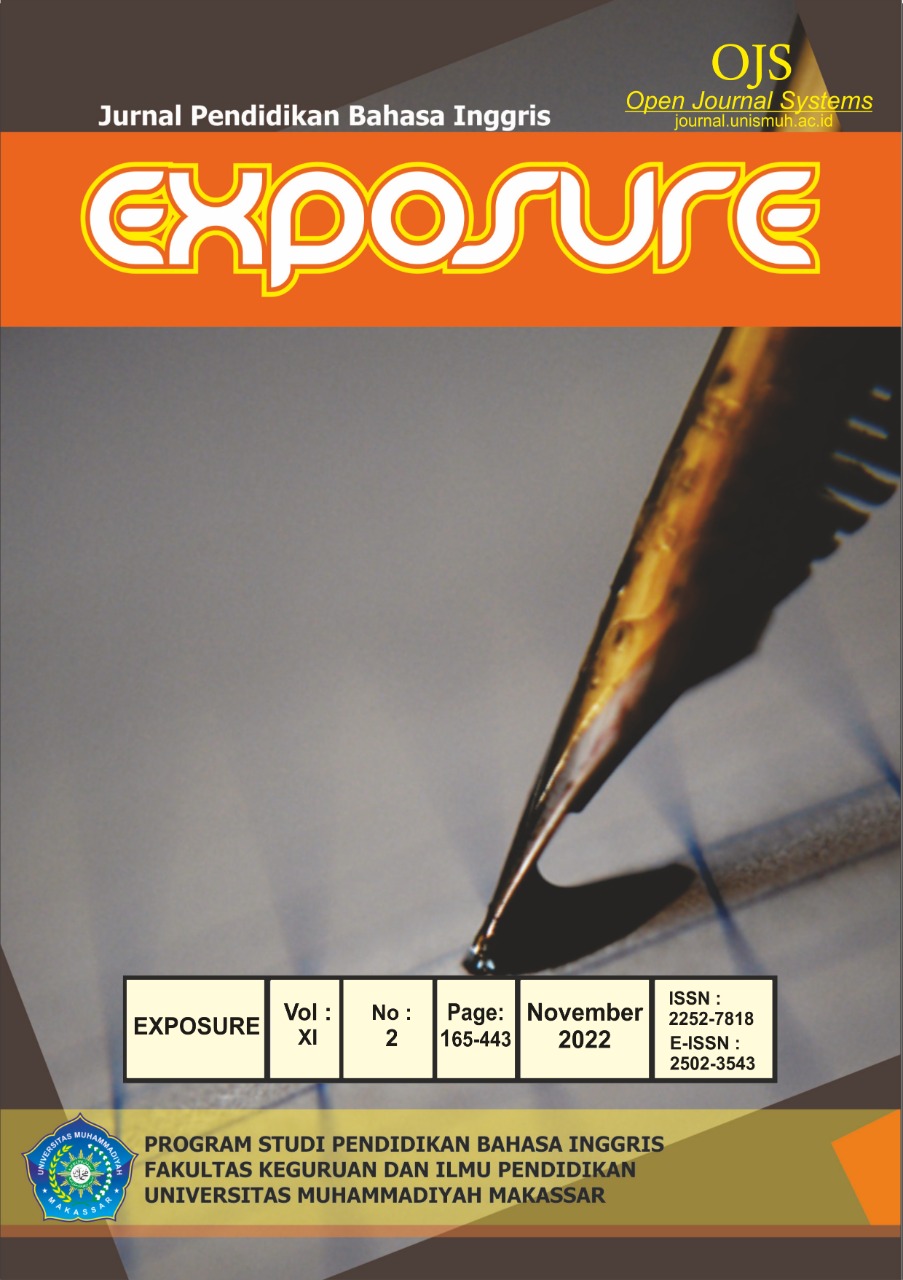STUDENTS’ MOTIVATION IN LEARNING ENGLISH BY GIVING WARM UP ACTIVITIES IN BEGINNING OF CLASS
DOI:
https://doi.org/10.26618/exposure.v11i2.8172Keywords:
Motivation, Warm-up, learning EnglishAbstract
The objective of this research was to find out Students’ motivation in learning English by giving warm-up activities at the beginning of class, (An Experimental Study at the Second Grade of SMPN 2 Mangarabombang, Kabupaten Takalar). This research applied a pre-experimental design with Pre-Questionnaire, Treatment and Post-Questionnaire. The population of this research was the second-grade students of SMPN 2 Mangarabombang, Kabupaten Takalar which consisted of VIII A, VIII B, and VIII. To find out the students’ involvement motivation, the researchers used a questionnaire. The questionnaire aimed to find the effects of warm-up activities on students’ motivation in learning English. The questionnaire used an attitude scale, they were: Strongly Agree (SA), Agree (A), Undecided (UN), Disagree (D), or Strongly Disagree (SD). The students answered the question based on their perspective and their opinion. Warm-up activities affected the students’ perspective on learning English after being treated. The mean was improved by 8.24%, ranging from54.3 to 60.9. It indicates that students have a positive perspective on learning English after giving warm-up activities at the beginning of class. Warm-up activities affected the students’ extrinsic motivation in learning English after being treated. The mean is improved (5.78%) ranging from 55 to 59.56, which indicates that students’ extrinsic motivation is increased after giving warm-up activities at the beginning of class. It also shows that warm-up activities can create a good atmosphere and positive perspective for students and encourage students to be involved in classroom activities. Concern about that facts and based on the data analysis above and students’ journal analysis, the researcher would like to conclude that warm-up activities can affect students’ perspective and student's extrinsic motivation in learning English. So, we can make warm-up activities one of the options to face the class.References
Allwright, R. (1984). The Importance of Interaction in Classroom Language Learning. Applied Linguistics, 5(2), 156-171.
Ames, C. and Archer, J. 1988. Achievement Goals In The Classroom: Student Learning Strategies And Motivation. Journal of Educational Psychology, 3, 260-276.
Anonym. 2014. Why You Should Always Start with a Warmer?. http://busyteacher. org/print:page,1,7610-why-you-should-always-start-with-a-warmer.html Anonym. 2014. Major Perspectives in Psychology. http://www.ccis.edu/courses /psyc101a/Major%20Perspectives%20in%20Psychology.htm
Astin, A. W. 1999. Student Involvement: A Developmental Theory for Higher Education. VOL. 40 NO. 5.
Baleghizadeh, Sasan. Abbas Timcheh Memar. and Hossein Timcheh Memar. (2011). A Sociocultural Perspective on Second Language Acquisition: The Effect of High-structured Scaffolding versus Low-structured Scaffolding on the Writing Ability of EFL Learners. Reflections on English Language Teaching, Vol. 10, No. 1, pp. 43–54.
Bandur,a Albert. 2003. The learning perspective. http://www.ship.edu
/~cgboeree/bandura.html
Brown, G. & G. Yule. 2000. Teaching the Spoken Language. Beijing: People Education Press.
Cáceres, L. P. E. 2010. Motivating Students through Warm ups. Pontificia Universidad Católica. Del ecuador sede Ambato.
Cherry, Kendra. 2015. What is Extrinsic Motivation?. http://psychology.about.com/od/eindex/f/extrinsic-motivation.htm
Chang, Hsin-Hui. 2005. The Relationship between Extrinsic/Intrinsic Motivation and Language Learning Strategies among College Students of English in Taiwan. A Thesis Master of Arts Degree. Taiwan: Ming Chuan University.
Chapelle, C.A., & Hegelheimer, V. (2004). The language teacher in the 21st century. In S. Fotos & C.M. Browne (Eds.), New perspectives on CALL for second language class-rooms(pp. 299–316). Mahwah, NJ: Lawrence Erlbaum Associates
Downloads
Published
Issue
Section
License
Authors who publish with this journal agree to the following terms:
In order to assure the highest standards for published articles, a peer review policy is applied. In pursue of the compliance with academic standards, all parties involved in the publishing process (the authors, the editors and the editorial board and the reviewers) agree to meet the responsibilities stated below in accordance to the Journal publication ethics and malpractice statement.
Duties of Authors:
- The author(s) warrant that the submitted article is an original work, which has not been previously published, and that they have obtained an agreement from any co-author(s) prior to the manuscript’s submission;
- The author(s) should not submit articles describing essentially the same research to more than one journal;
- The authors(s) make certain that the manuscript meets the terms of the Manuscript Submission Guideline regarding appropriate academic citation and that no copyright infringement occurs;
- The authors(s) should inform the editors about any conflict of interests and report any errors they subsequently, discover in their manuscript.
Duties of Editors and the Editorial Board:
- The editors, together with the editorial board, are responsible for deciding upon the publication or rejection of the submitted manuscripts based only on their originality, significance, and relevance to the domains of the journal;
- The editors evaluate the manuscripts compliance with academic criteria, the domains of the journal and the guidelines;
- The editors must at all times respect the confidentiality of any information pertaining to the submitted manuscripts;
- The editors assign the review of each manuscript to two reviewers chosen according to their domains of expertise. The editors must take into account any conflict of interest reported by the authors and the reviewers.
- The editors must ensure that the comments and recommendations of the reviewers are sent to the author(s) in due time and that the manuscripts are returned to the editors, who take the final decision to publish them or not.
Authors are permitted and encouraged to post online a pre-publication manuscript (but not the Publisher’s final formatted PDF version of the Work) in institutional repositories or on their Websites prior to and during the submission process, as it can lead to productive exchanges, as well as earlier and greater citation of published work (see The Effect of Open Access). Any such posting made before acceptance and publication of the Work shall be updated upon publication to include a reference to the Publisher-assigned DOI (Digital Object Identifier) and a link to the online abstract for the final published Work in the Journal.

